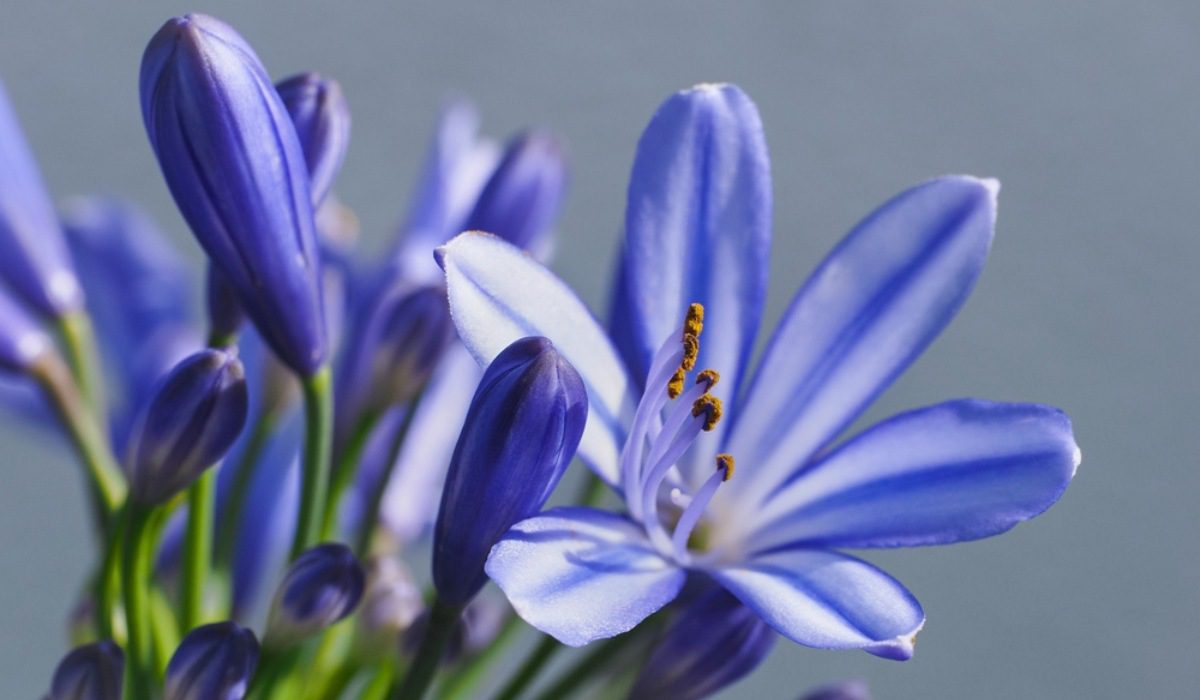The Agapanthus genus comprises six species of perennial plants with vivid bell-shaped blooms. They often bloom in hues of blue, pink, purple and white from the beginning of summer to the end of fall, with each petal having a darker centre stripe. Leaves splay widely and long from the base, while flowers grow on towering stalks. Depending on the type, the leaves can be either evergreen or deciduous, with colours ranging from dark to light green, grey-green or blue-green. In addition to being great as cut flowers and attracting hummingbirds, agapanthus blooms are resistant to rabbits and deer. Both people and animals can be poisoned by agapanthus.
See also: How to grow and care for Lisianthus?
Agapanthus: Key facts
| Common name | African lily, Lily-of-the-Nile |
| Botanical name | Agapanthus |
| Family | Agapanthaceae |
| Plant type | Herbaceous perennial |
| Mature size | 3 ft. tall, 2 ft. wide |
| Sun exposure | Full sun, part shade |
| Soil type | Sandy loam, well-drained |
| Soil pH | 5.5 to 7.5 |
| Bloom time | June, July, August, September |
| Native area | South Africa |
| Toxicity | Toxic to humans and pets |
Agapanthus: How to grow?
When planting agapanthus in warm climates, choose a time during late fall and in chilly climates, wait until spring to plant after the last frost. In a well-drained, wet soil, plant the rhizomes 12 to 24 inch deep. Positioned at the soil level, the root crown needs to be facing upward.
Dig a hole twice as wide and as deep in the garden as the nursery container. In the bottom of the hole, loosen the earth. Put on gloves and take the plant out of its container, using your hands to carefully release the roots. Place it in the hole at the same depth as the container. To eliminate air pockets, backfill the hole and press down. Mist the plant with water. The chosen variety will determine the proper spacing for many plants. Make sure to arrange the plants correctly by consulting the sticker that came with them. Potting soil-filled containers is another way that agapanthus can be grown.
Agapanthus: Care tips
Light
Six to eight hours of sun per day are necessary for optimal flower development in Agapanthus plants, which grow best in full sun. They do, however, benefit from some shade in very hot conditions.
Earth and Water
Pick a place where the soil is rich and has good drainage. Agapanthus plants dislike long periods of dryness and benefit from frequent watering. Water consistently to avoid stress impeding subsequent blooms, particularly in the immediate aftermath of a bloom cycle completion.
Heat and Humidity
In tropical climes, several kinds of agapanthus are evergreen. A little extra warmth and protection is needed during the cool season for the non-evergreen varieties. When autumn hits, start their dormancy by denying them some water. Move the more delicate evergreen kinds into a place that does not get frost, such as a greenhouse or a bright window in a house. Hardier plants can wait until spring and be given only a little water. Although it is not necessary, agapanthus can withstand high humidity.
Fertiliser
Fertilise agapanthus plants twice a year, as they blossom frequently. Once in the early spring and once more two months later. For a season full of blooms, give them a granular fertiliser that is balanced, such as 10-10-10, or one that has a little more phosphorus than nitrogen. As directed by the product label regarding usage quantity, water it thoroughly.
Pruning
In order for the plant to conserve energy for the next year, remove any damaged leaves as soon as possible, but leave the remaining leaves on the plant. When flowering has ended in late October, trim back agapanthus plants planted in the ground to a height of about four inch. Winter will bring the plant to a dormant state. Keep the plant safe by mulching its crown. Take off withered flowers from the stem to promote new development and save the plant from expending energy on seed formation during the flowering season.
Agapanthus: Harvesting
The main reason agapanthus is produced is for its beautiful flowers; to harvest it, the flower stalks are trimmed off for decoration. Trim the flower stems at the base with clean, sharp scissors or pruning shears, preferably after most buds have opened. Gathering fruit not only makes the plant seem better but it also promotes the growth of new flowers. Removing old flower heads also helps keep the plant from self-seeding, which helps maintain a neat and orderly garden.
Agapanthus: Toxicity
Commonly referred to as Lily of the Nile, agapanthus has a mildly poisonous potential when consumed. The plant has ingredients that can cause nausea, vomiting and upset stomachs. Skin-to-skin contact may irritate. Although not usually lethal, it is important to use caution and keep agapanthus out of children’s and animals’ reach. If consumed, get medical help; if it irritates your skin, wash the afflicted area well.
FAQs
What is Agapanthus?
Agapanthus, commonly known as Lily of the Nile, is a flowering plant known for its striking clusters of tubular flowers atop long stalks.
How to care for Agapanthus?
Plant in well-draining soil, provide full sunlight and water moderately. Divide clumps every few years to maintain vigour.
Is Agapanthus toxic?
Yes, Agapanthus can be mildly toxic if ingested. It may cause stomach discomfort and skin irritation. Keep it out of reach of children and pets.
Can Agapanthus be grown in containers?
Yes, Agapanthus is well-suited for container gardening. Use well-draining soil and choose a pot that allows room for root expansion.
When does Agapanthus bloom?
Agapanthus typically blooms in summer, producing showy globular flower clusters in various shades of blue, purple, or white.
How often one should water Agapanthus?
Water Agapanthus moderately, allowing the soil to dry out between waterings. It's relatively drought-tolerant once established.
Can Agapanthus tolerate cold weather?
Agapanthus is generally hardy but may need protection from severe frost. Mulch around the base to insulate roots in colder climates.
How to propagate Agapanthus?
Propagate Agapanthus by dividing established clumps in spring or early autumn. Ensure each division has healthy roots and foliage.
Are there different varieties of Agapanthus?
Yes, Agapanthus comes in various cultivars with differences in size, flower colour, and overall appearance.
Does Agapanthus attract pollinators?
Yes, Agapanthus flowers attract bees and butterflies, contributing to pollination in the garden.
| Got any questions or point of view on our article? We would love to hear from you. Write to our Editor-in-Chief Jhumur Ghosh at jhumur.ghosh1@housing.com |






